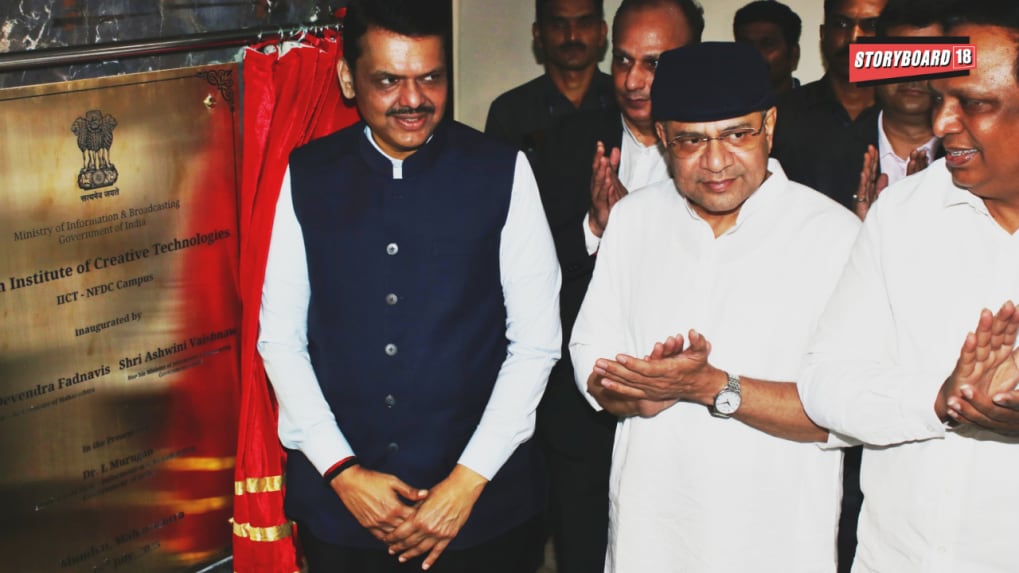MIB-led IICT eyes multi-state presence by 2027; Mumbai to remain central hub
Backed by a ₹400 crore investment, IICT is structured as a Public-Private Partnership (PPP), with the Ministry of Information and Broadcasting and Maharashtra Government holding 48% stake, and industry bodies CII and FICCI each holding 26%.
ADVERTISEMENT
The Ministry of Information and Broadcasting led initiative Indian Institute of Creative Technology (IICT) will expand its footprint across other states in the next two years. The new model of education that blends world-class infrastructure with industry-led curriculum has laid out the roadmap for this transformative initiative aimed at empowering professionals and nurturing creators in the AVGC-XR sector.
I&B Minister Ashwini Vaishnaw and Maharashtra CM Devendra Fadnavis, jointly inaugurated the campus of the Indian Institute of Creative Technologies (IICT) in Mumbai on July 18. Also present on the occasion was Sanjay Jaju, Secretary, Ministry of Information and Broadcasting, Government of India, and Minister of Cultural Affairs Department, Government of Maharashtra, Ashish Shelar.
The IICT will offer advanced programs in integrated media post-production, animation, VFX, XR, and other emerging technologies, bringing together academic expertise, industry collaboration, and state-of-the-art infrastructure under one roof.
Dr. Vishwas Deoskar, CEO of IICT in an interview with Storyboard18 emphasized, “Our objective is not just to train service providers, but to create a new generation of creators. We want Indian professionals to move up the value chain—from backend support roles to original content creators competing on a global stage.”
While the admission process is still underway, the courses have already garnered interest from candidates across various Indian states.
IICT is equipped with top-tier technology—some of it sourced directly from the United States—making it one of the few campuses in India with such advanced infrastructure. But the institution isn’t just about high-end tools. Accessibility is central to its philosophy.
“This is not just an elite campus,” Dr. Deoskar clarified. “We want students from economically weaker sections to have equal access. Our fee structure is designed to be affordable—comparable to government institutions—because we are a non-profit, government-backed and industry-supported organization.”
Backed by a ₹400 crore investment, IICT is structured as a Public-Private Partnership (PPP), with the Ministry of Information and Broadcasting and Maharashtra Government holding 48% stake, and industry bodies CII and FICCI each holding 26%. Importantly, the institution is registered as a Section 8 non-profit company, allowing for agility and innovation often hindered in traditional government-run models.
The current campus, developed in just two and a half months, is seen as a launchpad. “It’s a temporary setup to kickstart operations while the full-scale film city center is being developed, which will take over two years,” said Dr. Deoskar.
IICT’s curriculum is being crafted in close coordination with global industry leaders. The institute has already signed Memorandums of Understanding (MoUs) with tech giants like NVIDIA, Google, Apple, Microsoft, Adobe and major communication and design groups like WPP, NOWIN Gaming led Comic Con and Green Rain.
“The idea is to create a pipeline between industry needs and academic delivery. Our faculty includes ex-IITians and professionals with global credentials. We are preparing learners not for today’s industry—but for what’s coming next,” Dr. Deoskar added.
IICT envisions a 24-hour campus modeled after rigorous institutions like IIMs, where students can access resources any time to foster creativity and innovation. The university is also setting up incubation centers for entrepreneurship and IP development. “We are not teaching people to use tools—we are helping them build new tools and tell their own stories,” Dr. Deoskar said.
While five states—including Karnataka, Maharashtra, Telangana, Assam, and Madhya Pradesh—have expressed interest in hosting IICT campuses, Dr. Deoskar insists on building a solid foundation first. “Let the mother campus in Mumbai stabilize. Only then will we scale using a hub-and-spoke model. We’re not in a hurry to replicate without quality. The timelines we are looking at is atleast two years to enter into other states.”
The institution aims to enroll 150 to 200 students in its first year, with a target of 300 across 17 programs. Admissions are expected to begin in full swing by September 2025. “There is no benchmark for what we are doing,” Dr. Deoskar concluded. “We are the benchmark. And this is just the beginning.”
As India positions itself to tell its stories through gaming, animation, and immersive media, IICT is shaping up to be a cornerstone of the country’s creative future—where education meets imagination and innovation.
Read More: Prasar Bharati, Maha Govt, MFSCDC join hands to develop creative media ecosystem in Malad


